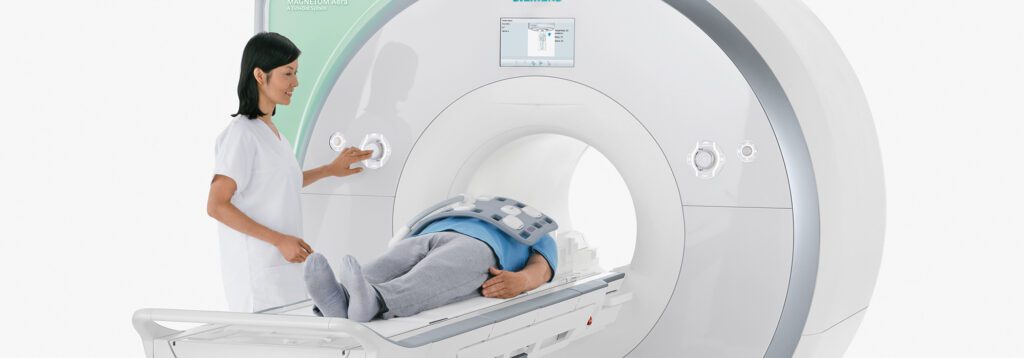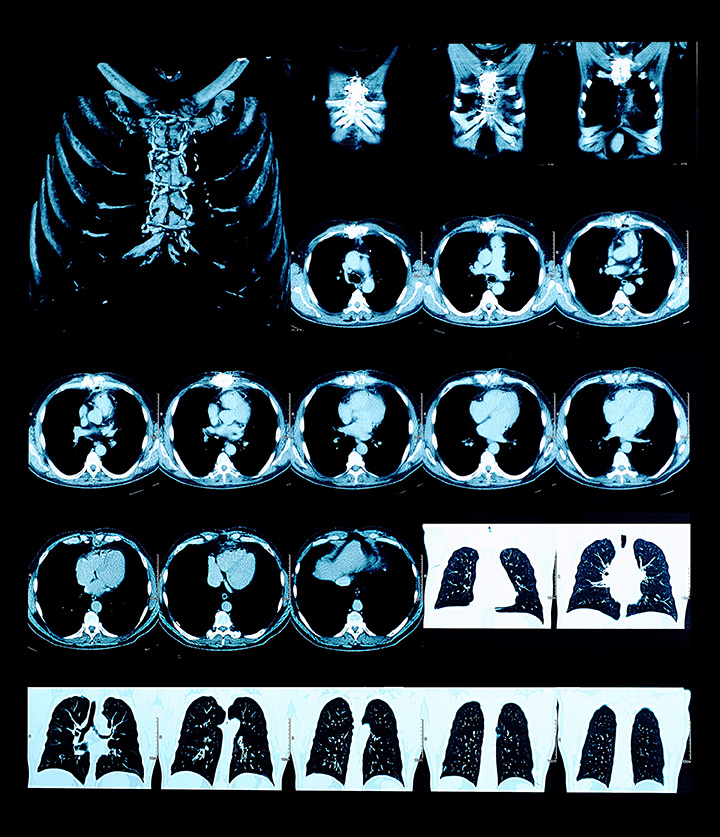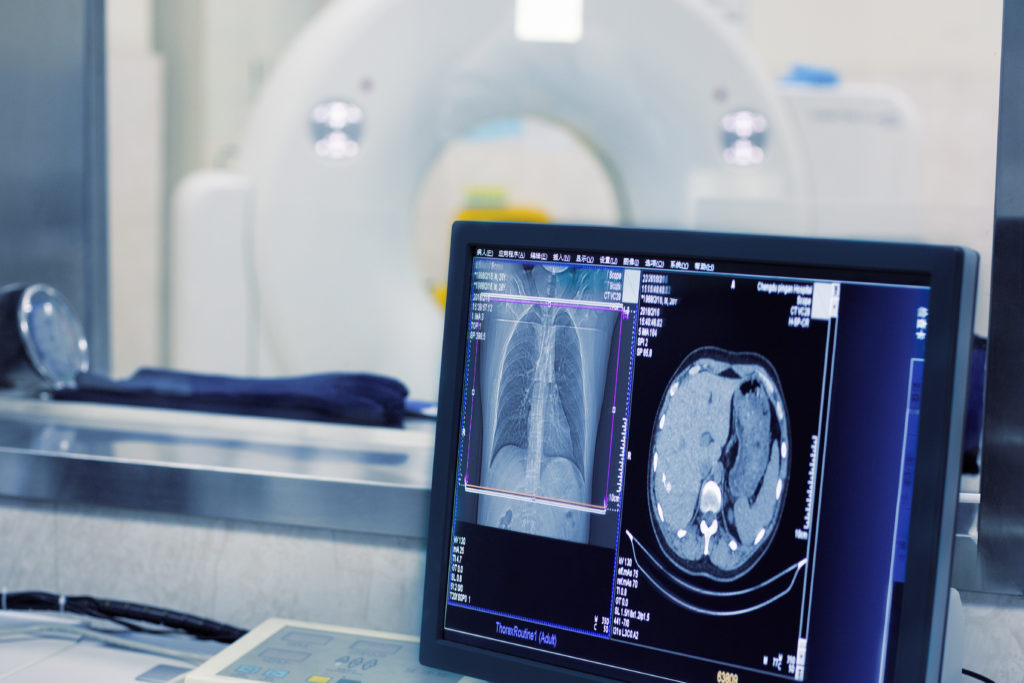You were worried when your doctor recommended a lung CT scan. It would be hard not to be a little worried, because a lung CT scan could mean many different things.
But rest assured, a lung CT scan doesn’t automatically mean something serious, like cancer. Your doctor just wants to get a closer look at your lungs.
We have all the information you’ll need to approach your lung CT scan with confidence. Here, we’ll answer your questions about what your scan could mean, and we’ll get you ready for your upcoming appointment.
Where to start – We know you’re anxious
Just hearing the words CT scan can send one’s mind spiraling towards the worst-case scenarios. But it’s essential to remember that a recommendation for a scan is not necessarily indicative of something severe. It’s OK to feel nervous about the process. After all, medical procedures, even non-invasive ones like CT scans, can be intimidating. However, understanding the process can help alleviate some of your concerns.
A CT scan is a diagnostic tool, one of many in a doctor’s arsenal, to help them see what’s happening inside your body more clearly. We’ll help guide you through the reasons why your doctor might suggest a lung CT scan, what you can expect during a lung CT scan, how to prepare for it, and debunk some common myths about the procedure.
Lung CT scans don’t just diagnose cancer
While it’s natural to jump to conclusions, a lung CT scan can be recommended for a wide variety of reasons, many of which are not serious or life-threatening.
Lung CT scans provide detailed images of your lung tissues and surrounding structures, making it easier for doctors to diagnose or rule out conditions ranging from infections and inflammation to tumors.
We will delve into the diversity of conditions that can be diagnosed using a lung CT scan, and how the imaging process works.


The Most Common Reasons for a Lung CT Scan
So your doctor has ordered a lung CT scan, and now you’re navigating through so much new information. We’re here to help make sense of it all. Let’s take a step-by-step look at the common reasons your doctor may have suggested this diagnostic tool.
Evaluating of your respiratory symptoms
Often, a lung CT scan is the next step in diagnosing persistent or unexplained respiratory symptoms. These symptoms could be a nagging cough, uncharacteristic shortness of breath, chest discomfort, or recurrent respiratory infections. A CT scan can shine a light on what’s going on.
- Persistent cough: A cough that lingers for weeks might be more than a stubborn cold or allergy. It could be a sign of an underlying lung condition such as bronchitis, pneumonia, or even a lung tumor. By providing a clear, detailed view of your lungs, a CT scan can help your doctor pinpoint what’s causing your persistent cough and, subsequently, provide appropriate treatment.
- Unexplained shortness of breath: Experiencing shortness of breath can be distressing. Several lung conditions such as asthma, Chronic Obstructive Pulmonary Disease (COPD), and Pulmonary Embolism (PE) could be the culprits. A lung CT scan can help distinguish between these conditions, providing essential insights to your doctor and bringing you a step closer to relief.
- Pain in your chest: Chest pain can have various causes, from heart conditions to lung-related issues. When it’s suspected that the pain originates from the lungs, a CT scan can help identify lung infections, blood clots in the lungs (pulmonary embolism), or even lung cancer. We’ll go into more depth about how a CT scan can be used in such scenarios.
- Recurring respiratory infections: If you’ve been experiencing recurring respiratory infections such as bronchitis or pneumonia, your doctor may order a lung CT scan. This diagnostic tool can identify if structural abnormalities or chronic infections are present, which could be contributing to the recurrence. The scan might also highlight any immune deficiencies that affect your lungs.
Screening for lung cancer
Although the words lung cancer screening might sound scary, it’s primarily a preventive measure. This procedure is particularly recommended for individuals who have a history of long-term smoking or other risk factors.
- The importance of early detection: Early detection plays a critical role in managing lung cancer. A CT scan can help catch this disease at an early stage when it is more likely to respond to treatment.
- Risk factors that may prompt a screening: Certain risk factors may increase the likelihood of developing lung cancer. These include age, a history of smoking, and exposure to harmful substances. A CT scan may be recommended if these risk factors are present to ensure early detection if lung cancer develops.
- The potential benefits and limitations of a lung cancer screening: While lung cancer screening can lead to early detection, it’s not without its benefits and limitations. We’ll explore these in detail, discussing how effective this screening can be, and some of the potential downsides, such as false-positive results.
- Understanding false-positive results: A false-positive result for lung cancer is when a screening test suggests that cancer may be present, but further testing reveals that there isn’t any. We’ll delve into what a false-positive result could mean for you, and why it’s important to understand the implications.
Assessment of pulmonary nodules or masses
Your doctor may order a lung CT scan if they detected pulmonary nodules or masses in previous imaging studies. A CT scan provides a more detailed image, which can help determine the nature of these nodules or masses.
- Nodules in your lungs: Pulmonary nodules are small, roundish spots seen on an imaging test. They could be due to old infections, scar tissue, or other causes. Many times, they’re benign, but in some cases, they might indicate early-stage lung cancer.
- Differentiating benign nodules from potentially malignant ones: One of the main reasons to perform a lung CT scan is to differentiate benign (non-cancerous) nodules from potentially malignant (cancerous) ones. By looking at the size, shape, and density of the nodules, doctors can get a better idea of whether they’re likely benign or need further investigation.
- Evaluating if you need further tests: Depending on the characteristics of the nodules observed on the CT scan, your doctor may suggest further investigations such as a biopsy, or simply regular monitoring.
- Exploring your treatment options: Depending on the nature of the pulmonary nodules, different treatment options might be considered. These could range from watchful waiting in the case of benign nodules to surgery or other treatments if the nodule is cancerous.
Monitoring your lungs
A lung CT scan isn’t just for diagnosis; it’s also an essential tool in monitoring the progression of existing lung conditions, assessing the effectiveness of ongoing treatment, and adjusting treatment plans if necessary.
- Checking on your existing lung conditions: If you’ve been diagnosed with a lung condition like pulmonary fibrosis or emphysema, a lung CT scan can provide valuable information on how the disease is progressing or responding to treatment.
- Assessing the effectiveness of your ongoing treatment: CT scans can give your doctor a detailed view of how your body is responding to treatment. It can show whether a tumor is shrinking, if a lung infection is clearing, or if a structural issue has been successfully corrected.
- Identifying disease progression: By regularly monitoring existing lung conditions with CT scans, doctors can catch signs of disease progression early. This can allow them to adjust your treatment plan promptly, ensuring you receive the most effective care.
- Tracking response to interventions: A lung CT scan can be particularly helpful in tracking your body’s response to interventions like surgery or radiation therapy. By comparing scans taken before and after these interventions, doctors can assess how well your body is healing or responding to treatment.
Remember that a CT scan is a tool to help ensure you’re getting the best possible care. It’s a step towards understanding and, ultimately, towards better health.


Preparing for Your Lung CT Scan
When your doctor orders a lung CT scan, it’s natural to feel a sense of anxiety or curiosity. We want to provide you with a detailed understanding of why this scan is recommended and how you can adequately prepare for it.
Understanding the purpose of the a lung CT scan
A lung CT scan is a non-invasive imaging procedure that provides highly detailed images of your lungs.
- Lung CT scans give your doctor valuable info: These images can assist doctors in diagnosing various health conditions, including pneumonia, lung cancer, pulmonary embolism, and tuberculosis, among others. This advanced imaging technology can also evaluate the effectiveness of ongoing treatments or monitor disease progression.
- Why your doctor ordered a lung CT: If your doctor has recommended a lung CT scan, it is likely due to certain symptoms or concerns that need to be investigated further. These may include persistent cough, chest pain, difficulty breathing, unexplained weight loss, or even incidental findings from a routine physical exam. The CT scan can provide more detailed information that other diagnostic methods might not reveal.
- How to get the best results from your lung CT: Your active participation and cooperation are essential for the success of the scan. Following instructions, such as holding your breath at specific times during the imaging, can help produce clearer images and potentially reduce the need for repeat scans. Don’t hesitate to ask questions or express concerns to your healthcare provider.
Dietary and medication guidelines
Our radiology technicians will give you specific instructions on what to eat and drink, as well as guidelines for taking any medication, and directions for managing any allergies. However, below are some general guidelines:
- Taking your medication: Your healthcare provider will give you specific instructions on taking medications before the scan. Some drugs might need to be paused, especially if a contrast agent is being used. Always ensure that your medical team is aware of any medications you are currently taking, including over-the-counter drugs and supplements.
- Individuals with diabetes or kidney problems: If you have diabetes or kidney disease, special precautions may need to be taken, particularly if a contrast material is involved. Adjustments might be required for your medications or the timing of the scan. Make sure your healthcare provider is aware of your medical history.
- Allergies and previous adverse reactions to contrast: If you’ve previously had any allergic reactions or adverse effects to contrast agents or any other substances, it’s crucial to inform your healthcare provider. Alternatives or pre-treatment to prevent reactions might be an option in these cases.
Clothing and personal belongings
Be careful when you’re preparing what to bring to your lung CT scan, and be sure to follow your doctor’s recommendations for what to do before your scan, since it could impact the results.
- What to wear on the day of your scan: Choose loose, comfortable clothing for your scan, but avoid clothes with zippers, buttons, or any metal. In some cases, you might be asked to wear a hospital gown.
- Restrictions on metal objects or jewelry: Jewelry, glasses, hearing aids, and other metallic objects may affect the CT images, so you’ll likely be asked to remove them. It’s often best to leave such items at home.
- Essential personal belongings: It’s advisable to only bring the essentials with you, leaving valuables at home. You might need to bring along your identification, insurance information, and a method of payment for any potential charges.
Accommodations for members of the disability community
Navigating the healthcare landscape can pose unique challenges for people with disabilities. At Touchstone Medical Imaging, we work to accommodate the diverse needs of patients preparing for a lung CT scan.
Ensuring physical accessibility: If you have mobility needs or a physical disability, please inform our team ahead of your appointment. We’ll insure we have someone to assist you.
Touchstone’s outpatient imaging facilities are designed to be accessible and equipped with tools such as wheelchair ramps, wide doorways, and adjustable scanning tables. Specialized lifting equipment or transfer aids may also be available to assist with getting onto the scanning table, if needed.
Before your appointment, be sure to get in touch to check on the accessibility of the location where you get your scan.
Catering to sensory and cognitive differences: Outpatient imaging centers can offer adjustments like scheduling appointments during quieter times, allowing extra time for the process, or providing clear step-by-step explanations about what’s happening.
A support person or caregiver’s presence can also be beneficial, providing reassurance and aiding communication between the patient and the healthcare providers.
Psychological preparation and support
Navigating the emotional aspects of a lung CT scan can be just as important as understanding the physical logistics. Let’s explore various strategies to manage anxiety and enhance comfort throughout the scanning process.
- Understanding the scanning procedure: Knowing what to expect during the scanning process can help reduce anxiety. Remember, the procedure is non-invasive, typically quick, and should not cause any pain. The machine might make some noise, but this is entirely normal.
- Communicating your claustrophobia: If you’re worried about feeling confined or claustrophobic during the scan, let your healthcare provider know. They can help you understand the size and space of the machine, offer tips for relaxation, or explore other potential solutions.
- Supportive measures: Having a loved one present before and after the procedure can provide significant emotional support. Visitors are not allowed in the CT room during scanning to prevent unnecessary radiation exposure.
Remember, your healthcare team’s ultimate goal is to ensure your comfort and safety while obtaining the necessary diagnostic information. By understanding and preparing for your lung CT scan, you’ll be playing an active role in your healthcare.
How to schedule a lung CT appointment with us
Touchstone Medical Imaging offers CT imaging in Arkansas, Colorado, Florida, Montana, Oklahoma, and Texas. Reach out to us at Touchstone, and we’ll help you schedule an appointment at an imaging center near you, today. Touchstone Medical Imaging has locations in Arkansas, Colorado,
Did you know our medical imaging CT and MRIs cost up to 60% less than what you pay at a hospital? We’re here to help you get the answers you need.
Frequently asked questions about a lung CT scan
Why has my doctor recommended a lung CT scan, and what does it mean?
Doctors recommend a lung CT scan as a diagnostic tool to further investigate potential concerns, such as unexplained respiratory symptoms, possible lung disease, or monitoring existing conditions. This recommendation doesn’t necessarily mean something serious; it’s a standard medical approach to gain a clearer picture of what’s happening in your lungs.
What specific role does a lung CT scan have in diagnosing various conditions?
A lung CT scan provides detailed, cross-sectional images of your lungs. It can identify abnormalities or changes in lung structure and function, like infections, tumors, or chronic lung diseases, which wouldn’t be detectable in a regular X-ray. This diagnostic ability aids doctors in making accurate diagnoses and developing effective treatment plans.
I'm feeling anxious about the CT scan. How can I address these feelings?
It’s normal to feel anxious about medical procedures. To manage this, it helps to gather detailed information about the scan, ask your healthcare provider any questions you have, and utilize relaxation techniques such as deep breathing or visualization. You may also want to bring a supportive friend or family member with you.
What common symptoms might prompt my doctor to recommend a lung CT scan?
If you experience persistent or unusual respiratory symptoms, like a chronic cough, difficulty breathing, chest pain, or coughing up blood, a doctor may recommend a lung CT scan to determine the cause. These symptoms could indicate various conditions, and a CT scan aids in precise diagnosis.
If I'm not at risk for lung cancer, why would I need a lung CT scan?
Although lung CT scans are a key tool in lung cancer screening, they’re not exclusive to cancer detection. Doctors also use them to investigate other lung conditions such as pneumonia, tuberculosis, emphysema, pulmonary fibrosis, or to examine suspicious areas following an X-ray.
How can a lung CT scan be used to assess pulmonary nodules or masses?
A lung CT scan provides detailed imagery of pulmonary nodules or masses, showing their size, shape, location, and density. This information can help doctors differentiate between benign and potentially malignant growths, guiding treatment decisions.
How can a lung CT scan help monitor the progression of existing lung conditions?
For patients with diagnosed lung diseases like chronic obstructive pulmonary disease (COPD), cystic fibrosis, or lung cancer, a CT scan can monitor disease progression, track changes over time, and assess the effectiveness of treatments.
What do I need to know about my diet and medication intake before a lung CT scan?
Prior to your scan, your doctor may instruct you to fast for a few hours. Certain medications might also need to be adjusted, particularly if contrast material is used during the scan. Always follow your doctor’s specific instructions to ensure the accuracy of the scan.
What should I wear, and what personal belongings should I bring for a lung CT scan?
Wear comfortable, loose-fitting clothing for your CT scan. You might be asked to wear a hospital gown and remove jewelry, glasses, or any metal objects as these can interfere with the scan’s accuracy. Bring only essential personal belongings.
How can I psychologically prepare myself for a lung CT scan?
Psychological preparation can include educating yourself about the scan, discussing any fears or concerns with your healthcare provider or loved ones, practicing relaxation techniques, and even seeking professional counseling if anxiety persists. Knowing what to expect can greatly help reduce fear and stress.


